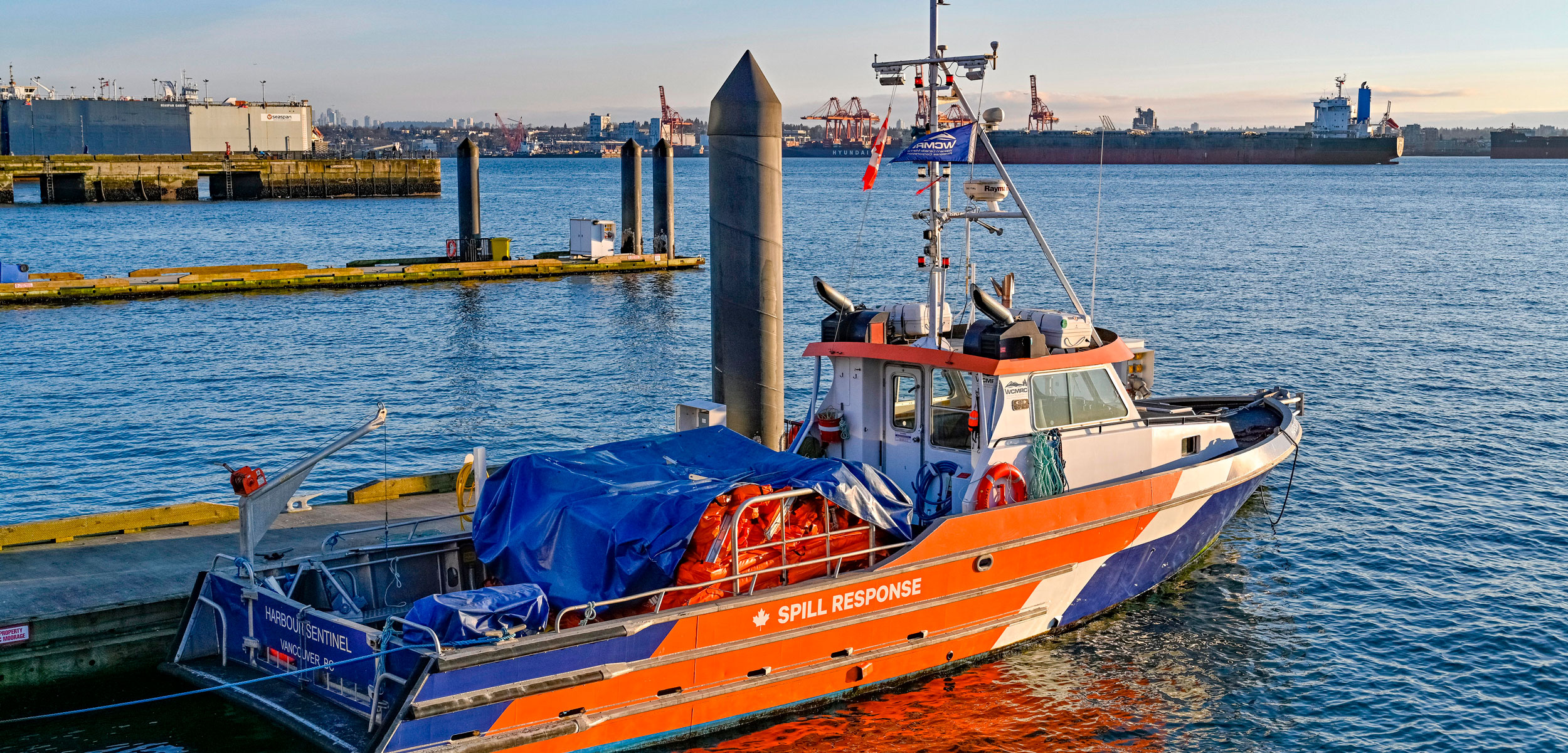Preparing For the Next Spill
On Canada’s west coast, oil spill cleanup capacity is expanding. But is it enough?
Article body copy
The Coastal Sentinel was designed to do one thing: clean up oil spills in the rough weather and big waves off British Columbia’s west coast. The CAN $5.8-million, 25-meter-long, custom-built ship is part of the Canadian government’s promise to create “world-leading” oil spill response capacity in the Pacific—an expansion tied to that of the Trans Mountain Pipeline. Now owned by the Canadian government, the contentious project will triple the amount of oil moving from Alberta to the Westridge Marine Terminal in Burnaby, near Vancouver, and increase the number of oil tankers plying BC waters from about 30 per year to 400.
“The increased tanker traffic increases the risk of a spill,” says Michael Lowry, manager of communications for Western Canada Marine Response Corporation (WCMRC), the company responsible for cleaning up oil spills on Canada’s Pacific coast and the owner of the Coastal Sentinel. “We need an enhanced spill response.”
So WCMRC is beefing up its infrastructure and staffing along the tanker route. The additions mean the coast is better equipped to respond to a spill than ever before. But critics aren’t convinced the company’s newfound capabilities are actually “world-leading.”
Transport Canada sets the country’s oil spill response standards, dictating things like how much oil has to be cleaned up and how quickly, and enforces a polluter-pay model for spills whereby the owner of the boat, pipeline, or tanker truck doing the spilling is supposed to pay the cost of the cleanup. As part of preparing for the Trans Mountain Pipeline, Lowry says WCMRC will voluntarily surpass Transport Canada’s standards, shaving hours off response times and doubling cleanup capacity.
To get there, the company is investing $150-million to add six new bases, increasing their workforce from 80 to 200 personnel, buying dozens of kilometers of booms and other specialty cleanup equipment, and adding 43 new boats to its fleet. They’re also expanding their planning and mapping, working with local communities—especially First Nations—to identify dangerous and sensitive areas, and creating detailed cleanup protocols and training local first responders. It’s part of a broader effort to address past criticism about transparency and communication, says Lowry. Everything will be ready and tested by the end of 2021, he says, six months before the scheduled completion of the pipeline expansion.
Those capabilities make Canada better prepared than most countries to deal with an oil spill, says Rashid Sumaila, a fisheries expert at the University of British Columbia who has researched the economic impact of oil spills. “Other jurisdictions like Washington State and Alaska are more prepared,” he adds. “But even they aren’t ready. Government and industry always say they are prepared, but spills always come with surprises that no one anticipated.”
Andrew Radzik is less impressed. “We’re not very ready for a major spill,” says the energy campaigner for the Georgia Strait Alliance, an environmental group. “And we do not have world-class spill response.” He doesn’t blame WCMRC. He blames the system the company works within.
The oil industry funds WCMRC through two pipes: a toll on every barrel of oil loaded onto a ship in BC waters, and a mandatory membership fee for commercial oil carriers operating in the province. In 2018, WCMRC’s annual budget was about $20-million. For the buildup, it’s risen to $50-million, with the Trans Mountain project funding the difference.
While WCMRC operates independently, it is governed by Transport Canada regulations, which are subject to political pressure, says Radzik, noting that 10 percent of federal GDP, $14.1-billion in 2017, comes from the energy sector. Add the Trans Mountain Pipeline project to the government’s portfolio and “the federal government has conflict of interest everywhere you look,” he continues. “The fox is guarding the henhouse.”
Among Radzik’s many concerns is Transport Canada’s low mandated standards. WCMRC’s capability to clean up 20,000 tonnes of oil in 10 days is double Transport Canada’s goal, but would only cover 20 percent of the oil a tanker will carry. Before the government bought Trans Mountain, its worst-case scenario planning used a 14,100-tonne spill. By contrast, neighboring Washington State’s regulations demand the capacity to clean up a spill of the vessel’s entire cargo plus fuel, says Radzik.*
Karen Wristen, executive director of Living Oceans, a British Columbia–based conservation organization, questions whether WCMRC will even be able to clean up any of the oil. The Trans Mountain Pipeline will primarily carry diluted bitumen, she says, which is a tar-like petroleum product made less viscous with chemicals so it will flow through pipes like conventional oil.
Recent research funded by the federal government investigating how diluted bitumen behaves in salt water suggests it will act like conventional oil. But Wristen says the testing didn’t reproduce ocean conditions. She expects that diluted bitumen will spread quickly and mostly sink, as seen in other heavy oil spills, making it more difficult to clean up.
“All the booms in the world will not corral it,” she says. “We need new technologies to track the oil and clean it up, even if it’s under the surface.” This technology is just emerging, and is not in WCMRC’s arsenal. Regardless, she says, a world-class spill response should not settle for the status quo.
“There’s a good reason we’re freaked out about an oil spill,” Radzik concludes. “It’s not some monster we conjured up. If you look at the nuts and bolts, they’re pretty rusty.”
*Correction: A previous version of this article used the wrong reference figures for the Trans Mountain Pipeline’s modeled worst case scenario spill, and Washington State’s required cleanup capacity.

